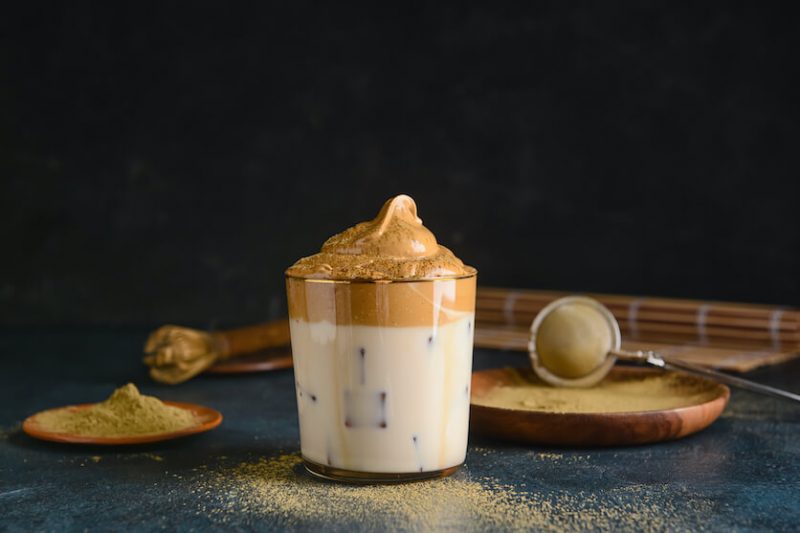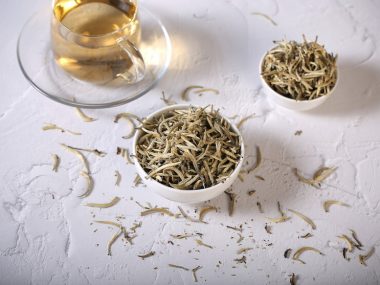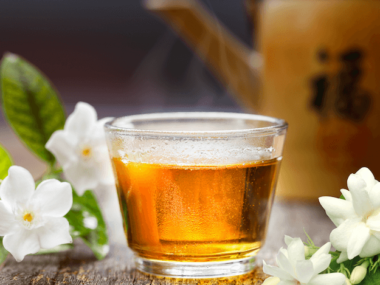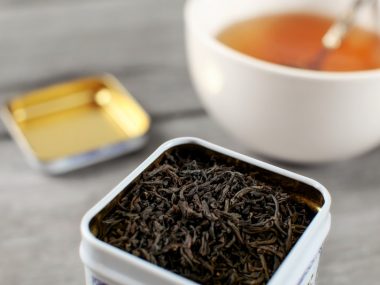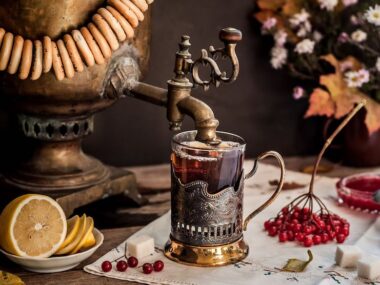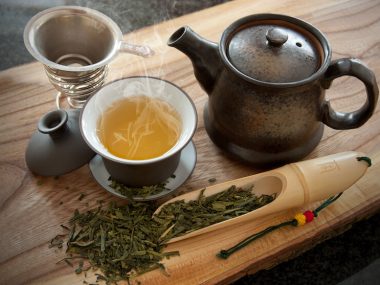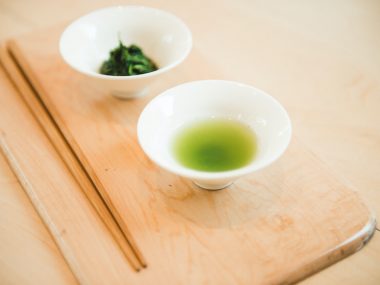How would you like to capture the relaxing and aromatic elements of a campfire and put it into a glass? Hojicha Latte is a drink that will trick your senses as your palate is challenged with an olfactory overload!
Table of Contents
What Is Hojicha Latte?
Hojicha Latte is a drink made from Hojicha (a green Japanese tea,) water, and milk. The ingredients are whisked with a bamboo whisk until it becomes frothy, similar to Matcha tea. This drink is enjoyed either hot or cold.
What Is Hojicha?
Hojicha tea hails from Japan with origins said to lie within Kyoto, Japan. The base of Hojicha Latte consists of Japanese pan-fried green tea called Hojicha. Hojicha tea leaves intended for Hojicha Latte are ground into an ultrafine powder. All of the flavors and qualities of the tea are still present in the hojicha powder form.
Hojicha tea is produced from the tea plant Camellia sinensis. Tea farmers take the leftover parts of tea plants (grown for other green teas) to process into Hojicha. Those “leftover parts” are what’s known as “coarse tea” or Bancha (twigs, stems, mature leaves on the lower part of the plant.)
Bancha is a low-grade tea and was once considered a pauper’s tea. In today’s tea industry, Bancha is a common tea enjoyed by all classes of society. A very long time ago, those who could not afford the better quality tea made from tea leaves gathered the remaining scraps of tea harvests to make tea. Roasting the tea scraps over a fire produced a tea that is one of the most enjoyed teas today (Hojicha).
Hojicha Processing
Tea plants intended other green teas go through early harvests, leaving the parts of the tea plant intact, which are intended for Bancha (which is what Hojicha is made from.) Tea farmers go back later in the year to harvest Bancha. This late harvesting method causes the remaining tea leaves to mature and become large.
The tea leaves are then taken back to the processing plant, where the work begins to produce Hojicha. Roasting the tea leaves is the key element when processing Hojicha. Various levels (classic, dark, and gold) of roasts achieve a specific flavor. However, these roasts do not come into play when making Hojicha powder.
When the processing method shifts from making traditional Hojicha tea to making Hojicha powder, the incoming tea leaves are steamed, dried, and lightly roasted. The now processed Hojicha tea leaves go through grounding to make a very fine powder that is as fine as cornstarch or powdered sugar. It’s vital that the tea powder be uniform and as fine as possible; otherwise, it fails to froth up when whisking into a latte.
Is Matcha Or Hojicha Better?
Usually, that’s a matter of personal preferences because the two teas taste somewhat different. Since the processing methods for the two also differ, each has several unique characteristics we compare below.
|
Matcha |
Hojicha |
|
Made from Tencha tea leaves which are shaded just before harvest time |
Made from Bancha (mature tea leaves harvested late) |
|
Processed by steaming |
Processed by roasting |
|
Has vibrant green color |
Has cinnamon color |
|
Has more caffeine and phenols (benefits.) |
Is lower in caffeine and phenols |
|
Tastes vegetal and earthy (sometimes bitter) |
Tastes smoky and earthy |
If you are aiming to select one of these two teas from a health perspective, Matcha is the one. As for overall taste, Hojicha might appeal to more people.
What Does Hojicha Latte Taste Like?
If we were to bundle up the flavors found in a Hojicha Latte, it would come close to a “creamy campfire.” As odd as that may sound, you have the beautiful smoky notes in the Hojicha, which are reminiscent of the aroma of sitting by a campfire on a cold night. The creamy smoothness of the latte obviously comes from the added milk, but it seems to compliment the smokiness perfectly.
How Much Caffeine Does Hojicha Latte Have?
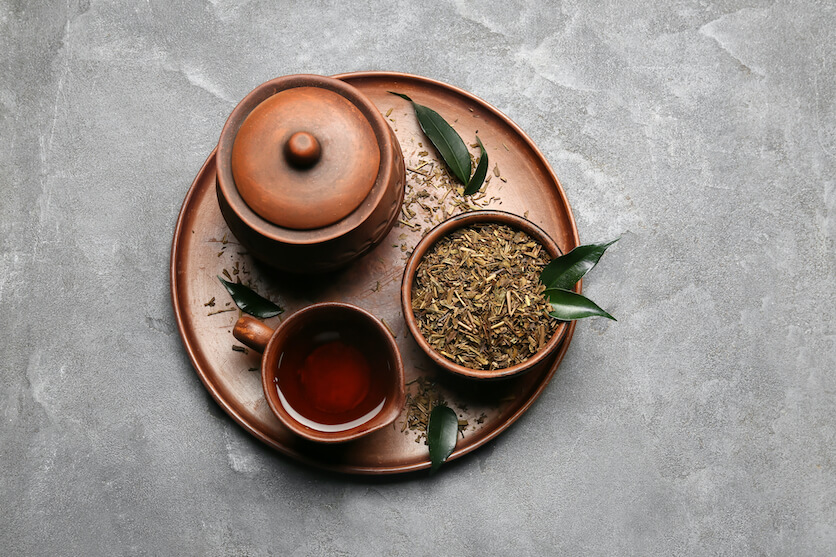
One of the things that attract tea drinkers to enjoy Hojicha tea or a latte made from it is its low caffeine it is. A six-ounce cup of Hojicha yields about 7.7 mg of caffeine, according to a published article entitled, “Contents of Individual Tea Catechins and Caffeine in Japanese Green Tea.”
The article goes on to mention theanine which is present in Hojicha. Theanine counteracts the side effects (jitters, rapid heartbeat, etc.) of caffeine. Because of this, you can confidently enjoy a Hojicha Latte as an evening tea.
Can I Drink Hojicha Latte Every Day?
The only things holding you back from enjoying this tea daily are if you are intolerant of the added milk, have any medical conditions, or are taking any special medications. Consult with your healthcare provider to find out if any tea is safe for you to consume.
Hojicha Latte Benefits
Hojicha delivers numerous benefits because it is a green tea. So, if you’re wondering, “Is Hojicha good for you?” That would be a big yes! Whether it’s in latte form or unadulterated, you still reap the pluses that this tea delivers. Japanese green teas (including Hojicha) are good for the immune system. It helps you to fight those nasty colds and viruses, and even acts against the pains and inflammation of arthritis.
Green tea is noted as beneficial in the Journal Of Indian Society Of Periodontology. Catechins in green tea help to prevent gum disease and bacteria in our mouth. Phenols in the tea also ward off bad breath. The British Pharmacological Society Journal highlights green tea’s phenols as being immune boosters, inhibitors of enteroviruses, flu, colds, upper respiratory infections, and more.
Lastly, the dairy (milk) added to complete the Hojicha Latte provides the added benefit of calcium and Vitamin D.
Can Hojicha Latte Be Bad For You?
Those who suffer from lactose intolerance may not find a Hojicha Latte easy to digest because of the sugar in the milk. If you happen to have this condition, don’t lose hope because replacing regular milk with a lactose-free alternative such as Lactaid milk or Dairy Pure is an alternative.
Another medical condition worthy of mentioning when it comes to drinking any tea is GERD (gastroesophageal reflux disease.) A medical paper published entitled “Association Between Tea Consumption and Gastroesophageal Reflux Disease” discusses how tea consumption may aggravate GERD. If this applies to you, unfortunately, the only alternative to tea would be water.
How To Make Hojicha
We have a wonderful Hojicha Latte recipe for you to try. There’s a bonus recipe included that you’ll love if you are a green tea drinker.
Hojicha Latte Straight Up
Ingredients
- 1 teaspoon of Hojicha powder
- 4 tablespoons of water
- ¾ cup of milk (whole, skim, almond, oat, etc.)
- ½ teaspoon honey (optional: to sweeten)
Directions
- Heat the water until it reaches 176 degrees (F) (about 80 degrees C.)
- Remove from the heat.
- Place the Hojicha powder into a heavy bowl.
- Add the hot water to the Hojicha powder.
- Whisk with a bamboo Matcha whisk or electric frother until thoroughly mixed and frothy looking
- Warm the milk.
- Use a steamer or frother to froth the milk in a separate container.
- Pour the Hojicha into a teacup.
- Pour the hot milk over the Hojicha tea.
- Now enjoy!
Tip: A clear teacup allows you to fully experience the taste and appearance of this luscious drink!
“Matchjicha Magic”
We take Hojicha Latte and Matcha to a new level by layering the two. The contrasting colors in a clear glass and the layers of flavors make this drink a dessert.
Ingredients
- 1 teaspoon of Hojicha powder
- ¼ teaspoon of Matcha powder
- 8 tablespoons of hot water
- 1 cup of milk (or your choice of dairy)
Directions
- Heat the water until it reaches (176 degrees (F) (80 degrees C.)
- Remove from the heat.
- Place the Hojicha powder into a heavy bowl, add 4 tablespoons of hot water and whisk until frothy. Set aside.
- Place the Matcha powder into a heavy bowl, add 4 tablespoons of hot water, and whisk until frothy. Set aside.
- Warm the milk until hot.
- Steam or froth the hot milk.
- Layer the Hojicha, Matcha, and frothy milk inside a clear glass.
- Hojicha on the bottom.
- Pour half of the frothy milk on top of the Hojicha.
- Gently pour the Matcha on top of the frothy milk.
- Pour the other half of the frothy milk on top.
- Insert a straw and drink to your heart’s content!
Tip: To sweeten this drink, add a few cubes of beet sugar to the water during heating.
Pairing Tip: Try adding a bit of Hojicha powder to your next batch of cookies or cake. Your family or guests will most definitely grill you to find out what that secret ingredient is that makes it taste so delicious.
Hold On To Hojicha Latte — It’s A Good One!
The tea world just got a whole lot better with different ways to enjoy teas. Hojicha Latte is an example of just how creative you can get with a tea. The robustness and smoky elements of Hojicha with the creaminess of milk are the ultimate tea indulgence.
